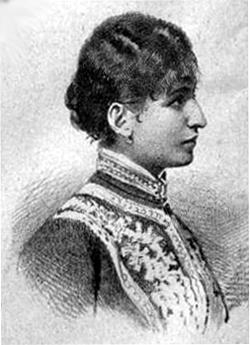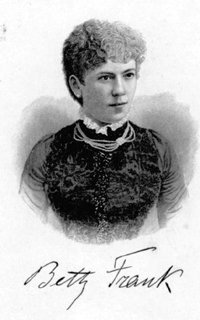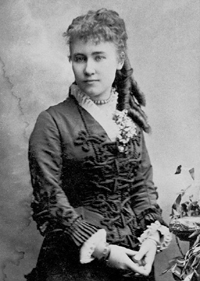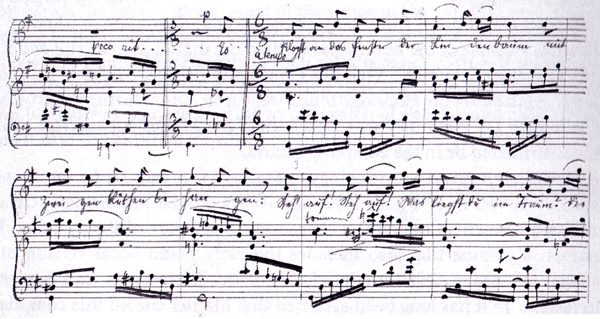
| |
Lieder und Gesänge, vol. I
No.1: Frühlingsmorgen – AVh
US-CLAc
Honnold/Mudd Library, Ernestine Schumann-Heink Collection
Lieder und Gesänge – Manuscript sources
Lieder und Gesänge – Main page
Catalogue Homepage
|
|
| 1 |
Katherina Rosen and Betty Frank joined the Deutsches klg. Landestheater at the same time as Mahler, in the
summer of 1885. Both were sopranos, Rosen specialising in
dramatic roles (such as Sieglinde) and Frank soubrette and
coloratura roles. On 11 April both were scheduled to perform in
Così fan tutte, Rosen as Leonore, Frank as
Despina. |
|
| |
|
|
| |

Katharina Rosen (1885)
Der Humorist,
30.09.1885, p. 4 |
|
| |
|
|
| |

Betty Frank
www.gustav-mahler.eu |
|
| |
|
|
| |

Bianca Bianchi
(1855–1947) |
|
|
|
|
Title
|
| |
Frühlingsmorgen! [G major] |
|
Date |
| |
[before April 1886?] |
|
Calligraphy |
| |
Autograph, black ink |
|
Paper |
| |
16 staves, no maker's
mark,
no watermark, upright format, 325 ´
250 (r not recorded) |
|
Manuscript structure and collation |
| |
1 bifolio: 1r = bb. 1–19
1v = bb. 20–35
2r = blank
2v = blank |
|
Provenance |
| |
Possibly a gift from Mahler to Ernestine
Schumann-Heink (1861–1936); bequeathed to Pomona College (one of
the colleges that make up Claremont Colleges, California) in
1938. |
|
Facsimiles |
| |
Complete colour facsimile |
|
Select Bibliography |
| |
SHNSF;
Ernestine Schumann-Heink Homepage |
|
Notes |
| |
This manuscript has not been examined:
the physical description is from
SHNSF.
It is a fair copy that shows no
evidence of use, supporting Stephen Hefling's view (SHNSF) that the
manuscript may have been donated to Schumann-Heink by Mahler, though the
possibility that she acquired it by another route cannot be
excluded. Its date cannot be established with any certainty: a
high-voice version must have existed by the time of its (first?)
performance on 18 April 1886 at a
concert in Prague: it was to have been sung by Katherina Rosen,
but she was indisposed, and was replaced by Betty Frank (1860 or
1864–after 1912).[1] However,
Stephen Hefling points out that AVh is
written on the same paper as a recently discovered autograph of
Scheiden und Meiden and concludes that the two
manuscripts 'are therefore almost certainly contemporaneous' and
'were written between July 1887... and November 1889' (SHNSS,
52), so it seems possible that they were prepared for use by
Bianca Bianchi for her performances with Mahler in Budapest on
13 November 1889.
A comparison of the
facsimiles of AVh and
AVc emphasises that although both are fair copies, there are
notable differences, chiefly:
-
AVh adopts the
high voice key of G major; in AVc Mahler initially notated
the key signature of G major and then immediately
revised it to that of F major. Whether thereafter Mahler was
transposing as he wrote, or copying from an existing (but
now lost F major manuscript) cannot be determined.
-
Articulation
and phrasing in the piano part of AVh2
are specified in much less detail than in AVc: perhaps
Mahler only intended the former for his own use or for use by a
singer. It is worth recalling that on 18 April 1886 he
accompanied a performance of the song by the soprano Betty
Frank, replacing an indisposed Katherina Rosen,[1] at a
concert in Prague: Mahler would have needed to prepare a high-voice
copy for Rosen ahead of the event.
-
In bar
7, the vocal line of AVh sets a version of the text close to
Leander's
original, but AVc Mahler alters both the text ('mit
den
Zweigen'
is replaced by 'mit
Zweigen')
and the vocal contour, readings that are adopted in the
published versions:

Fig. 1
Mahler: Frühlingsmorgen, AVh,
bb. 4–8

Fig. 2
Mahler: Frühlingsmorgen, AVc, bb. 4–11
-
In two
other important instances a reading in AVh differs from AVc but
agrees with that of
the first edition (c.f. the variant readings listed in
SWXIII/5, viii):
- b. 9: AVh
includes two notes omitted from the piano rh in AVc
- b.
12: in AVc the pitch of the 5th quaver, rh, lower part,
is erroneously written as f'; according to AVh and the
first edition it should be a'.
The missing copy of the song
by Weidig,
[ACV] would undoubtedly offer some clues about how
its text was arrived at, especially in these three passages, but
in its absence the
conjectural stemma for the volume tentatively proposes that
Mahler or Weidig may have drawn on an earlier (and now unlocated)
low-voice autograph manuscript of
the song
[AVt1] and/or AVh2 to clarify various passages in AVc
(though other scenarios are certainly possible).
Variant readings:
| Bar |
System |
Reading |
AV2h |
AVc |
PV |
| 1 |
pf |
nicht eilen |
N |
N |
Y |
| 3 |
lh |
slur |
N |
Y |
Y |
| 4 |
rh |
staccato dots
|
N |
Y |
Y |
| 4 |
|
poco rit on 1st
quaver |
Y |
N |
N |
| 4–5 |
rh |
lower part: slur
|
Y |
N |
Y |
| 5 |
lh |
staccoto dots
|
N |
Y |
Y |
| 6 |
|
a tempo |
Y |
Y |
N |
| 6–7 |
rh |
slurs |
N |
Y |
Y |
| 6–18 |
lh |
slurs |
N |
Y |
Y |
| 7 |
v |
semi-quavers on last beat |
N |
Y |
N |
| 8 |
lh |
natural for last
semi-quaver
|
N |
N |
Y |
| 9 |
rh |
lower notes of 1st beat
omitted |
Y |
N |
Y |
| |
v |
cautionary accidental |
N |
N |
Y |
| |
lh |
accidental for lowest
note |
N |
N |
Y |
| 10 |
rh |
slur and staccato dots |
N |
Y |
Y |
| 11–12 |
lh |
arppegiation added |
N |
N |
Y |
| 11 |
rh |
slurs omitted |
N |
Y |
Y |
| 12 |
lh |
staccato dots omitted |
Y |
N |
N |
| 12 |
rh |
f2 not g2 |
N |
Y |
N |
| 13 |
|
poco rit. |
N |
N |
Y |
| 13 |
pf |
hairpins replaced by
accents |
N |
N |
Y |
| 14 |
|
rit. |
N |
N |
Y |
| |
pf |
2nd beat: |
ppp |
pp |
nil |
| 15 |
pf |
1st beat |
nil |
> |
ppp |
| 16.1 |
pf |
pp |
Y |
N |
Y |
| |
pf |
ohne nachschlag |
N |
N |
Y |
| |
pf |
a tempo |
N |
N |
Y |
| 16 |
rh |
slur over upper part or
below alto |
over |
over |
below |
| 17 |
pf |
pp |
(Y) |
Y |
N |
| 17 |
rh |
slur over upper part or
below alto |
over |
none |
below |
| 18 |
rh |
slurs omitted |
N |
Y |
N |
| 18–19 |
lh |
slurs omitted |
Y |
N/Y |
N |
| 20–21 |
lh |
slurs omitted |
N |
Y |
N |
| 20 |
v |
|
p |
pp |
p |
| 21 |
lh |
low A |
N |
N |
Y |
| 22–23 |
pf |
harpins |
N |
Y |
N |
| 24–5 |
pf |
arpeggiation |
N |
N |
Y |
| 25 |
pf |
hairpin |
N |
N |
Y |
| 26 |
pf |
p |
N |
N |
Y |
| |
pf |
ped. |
Y |
N |
Y |
| 28 |
pf |
hairpin |
N |
Y |
N |
| 33–34 |
pf |
slur |
Y |
N |
? |
| 34 |
|
|
ppp |
pppp |
ppp |
|
| |
|
|



